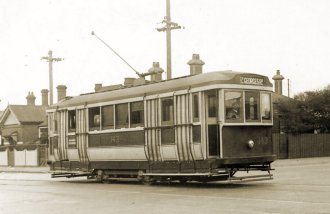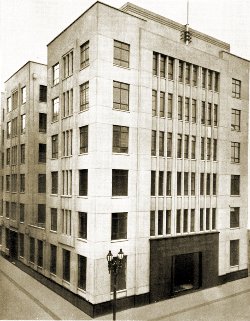Melbourne Tram Museum
- Follow Melbourne Tram Museum on Twitter
- Follow Melbourne Tram Museum on Facebook
- Follow Melbourne Tram Museum on Instagram
- Follow Melbourne Tram Museum on Pinterest
- Follow Melbourne Tram Museum on Tumblr
- Subscribe to Melbourne Tram Museum's RSS feed
- Email Melbourne Tram Museum
Fares please! An economic history of the Melbourne & Metropolitan Tramways Board
The Great Depression and its aftermath
The onset of the Great Depression caused cable conversion work and new tramline construction to grind to a halt for five years. Construction of new tramcars did not cease, but was reduced to a fraction of that experienced in the 1920s. This reduced programme made use of second-hand components from scrapped single truck cars. The main reason for the retention of this programme was to ensure that the Preston Workshops retained the skills to produce new tramcars, and to provide employment to its workers.
In order to reduce operating costs, the Board ceased bus services. The workforce was reduced by just over 900 between 1929 and 1932, and capital expenditure cut to a fraction of what was spent during the 1920s. Furthermore, the Board reduced the frequency of tram services to something more commensurate with the lower patronage and reduced the salaries of executives and Board members, in order to show solidarity with the workforce.
The one-hundredth anniversary of white settlement in Victoria in 1934-35 brought improving economic circumstances. As an indication of this, the voluntary reductions in executive and Board member salaries ceased as from the 1 January 1935. This year also saw the retirement of Alex Cameron as Chairman, and his replacement by Hector H. Bell.
 M&MTB Q class No 143 in Holden Street, 1938.
M&MTB Q class No 143 in Holden Street, 1938. - Photograph courtesy Dr A.K. Sewell.
A decision was made to recommence the cable to electric conversion program after a gap of five years, but this was to be achieved without any additional borrowings, at least for the first year of the resumed programme. As a result of this decision, the programme to build new tramcars using mechanical and electrical components from scrapped tramcars was halted, the order for 39 CW5 tramcars being cancelled after only five were built [10]. Instead it was decided to proceed with the construction of brand-new tramcars, an order for 120 W5 cars being placed.
The cable conversion programme restarted with the North Melbourne and Brunswick routes, which required the construction of the Brunswick Depot. The dates for progressive conversions to electric traction were:
- North Melbourne – 29 September 1935
- Brunswick – 26 April 1936
- South Melbourne – 25 July 1937.
In addition, construction of new electric lines [11] extending existing routes was undertaken between 1935 and 1938. However, on lightly trafficked cable routes, it was decided to substitute bus [12] operation:
- West Melbourne – 20 July 1935
- Rathdowne Street – 1 August 1936
- Port Melbourne – 13 March 1937
- Collingwood – 15 April 1939.
This was a major shift in policy, reinforced by an overseas study tour by the Chairman. He returned vastly impressed by the advances in diesel bus technology, and subsequently the Board made the decision that the remaining Bourke Street cable tram routes that had been slated for conversion to electric operation would instead be replaced by bus operation. This decision was supported on the grounds that if unsuccessful, the buses could be used to pioneer new routes and Bourke Street converted to electric traction.
As part of the same tour, Bell saw the first results of the PCC tramcar development in the United States. These cars were a revolution in terms of speed, acceleration, comfort and quietness. He determined that this should be the future direction of tramcar design for Melbourne, and persuaded the Board to obtain the Australian licence rights, with the objective of importing a trial car as soon as possible.
These activities did not stop development of the standard Melbourne tramcar. The first ‘luxury’ SW6 tramcar (no. 850) was launched in 1939, offering the travelling public upholstered comfort in a saloon style body. By this stage, the M&MTB was the largest bus operator in Melbourne. The cable tram workshops in Nicholson Street were converted to the Central Bus Garage, where all major bus maintenance took place.
In the meantime passenger traffic was steadily increasing from its nadir in 1932-33, but did not exhibit the explosive growth of the early years of the M&MTB. The improving conditions encouraged the M&MTB to introduce Sunday morning services in October 1936 during the formerly sacrosanct church hours. All-night services were commenced on a number of electric lines, which unfortunately ran at a loss that consumed the profits from the popular Sunday morning services. New bus routes were introduced in 1936:
- City – Fisherman’s Bend
- City – Williamstown (via ferry)
- Footscray – Sunshine
- Footscray – Moonee Ponds.
 M&MTB Head Office, 616 Little Collins Street, 1937.
M&MTB Head Office, 616 Little Collins Street, 1937. - Official M&MTB photograph.
The renewed growth of the Board also put pressure on space at Head Office. In 1938 the Board moved into a new office building at 616 Little Collins Street at the rear of the former MTOC headquarters at 673 Bourke Street, which it had occupied since 1919. A.G. Monsborough, the Board’s architect, designed the building. He also designed many tramway buildings still in use today, including the Wattle Park Chalet, before his death during the same year as the completion of the new headquarters.
The last financial year prior to the outbreak of war saw the M&MTB produce a small surplus, assisted by the ceasing in 1938 of the obligation to provide payments to State Government consolidated revenue to support the Licensing Fund.
Footnotes
[10] The CW5 tramcars (nos. 681-685) used traction equipment from scrapped maximum traction C class cars built for the P&MTT twenty years earlier. The design was unsuccessful, being underpowered in comparison with the earlier W class designs, and the wider body mounted on maximum traction trucks led to stability problems. The CW5 trams were withdrawn and modified to be compliant with the W5 class in 1956, after a traffic accident in which a CW5 tram toppled over onto its side.
[11] New electric routes constructed in the 1930s were:
- Moreland Road (Sydney Road – Railway) – 26 April 1936
- Keilor Road (Gillies Street – Birdwood Street) – 7 February 1937
- Doncaster Road (Burke Road – Bulleen Road) – 13 June 1937
- Clarendon & Spencer Streets (Flinders Street – City Road) – 25 July 1937
- Hawthorn Road (North Road – Point Nepean Road) – 5 December 1937
- Doncaster Road (Bulleen Road – Balwyn Road) – 11 December 1938
[12] Bell strongly favoured Leyland buses over other makes – a preference that was reinforced by an overseas study tour to the UK in 1935. It was also rumoured that he had a falling out with the Australian agent for AEC, which was Leyland’s main competitor throughout the British Empire. Bell’s preference was held despite AEC maintaining an industry acknowledged technological advantage in bus and engine design over Leyland. The M&MTB preference for Leyland would not be reversed until Bell was replaced by Risson as Chairman.